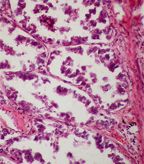Preventing Breast Cancer Progression
A new study by researchers at the Scripps Research Institute has identified a metabolic mechanism by which breast tumor cells control tumor aggressiveness.
A new study has identified a metabolic mechanism by which breast tumor cells control tumor aggressiveness. Researchers at the Scripps Research Institute found mutations in mitochondrial DNA that could be partly responsible for the switch to an aggressive breast tumor cell phenotype. Brunhilde H. Felding, PhD, associate professor, and colleagues also tested an already existing treatment that may help prevent cancer progression, finding that in a mouse model the therapy can inhibit cancer progression and prolong life. These results are published in the Journal of Clinical Investigation.

Metastatic breast carcinoma with lepidic growth pattern: It is well known that metastatic carcinoma in the lung may grow along the alveolar wall in a lepidic pattern simulating the appearance of primary pulmonary adenocarcinoma
in situ
(formerly bronchioloalveolar carcinoma); source: Yale Rosen, MD
Tumor cells use an altered form of metabolism that is linked to dysfunction of the mitochondria, the energy-generating organelle of the cell. Previous studies have shown that the balance of the key products of cellular respiration, nicotinamide adenine dinucleotide (NAD+) and NADH, are altered in tumor cells, which promotes generation of reactive oxygen species (ROS), uncontrolled tumor growth, and DNA damage. It has also been shown that mutations that lead to mitochondrial dysfunction have a role in tumor progression and metastasis.
“Our report is the first to establish a cause and effect relationship between aberrant mitochondrial complex I activity and aggressiveness of cancer cells,” said Felding. “Mutations in complex I encoding genes have been reported for a number of cancers, including oncocytoma and breast cancer; however, a functional link between such mutations, altered mitochondrial function, and the establishment of an aggressive phenotype had not been defined.” Mutations in other pathways, including KRAS, have also been found to result in lower activity of complex I, resulting in an aggressive tumor type.
Using aggressive triple-negative breast cancer cell lines, the interdisciplinary team found that the balance of NAD+ and NADH, which are processed by complex I, was disturbed in aggressive breast tumor cells. Increased activity of complex I in these cells interfered with tumor growth, while inhibition of the complex I resulted in increased metastatic potential. Additionally, increased NADH over NAD+ species also caused increased tumor growth. This is the first demonstration that alterations in complex I and the cellular NAD+/NADH balance affect tumorigenesis and metastasis in breast or other cancers, according to Felding.
Increasing NAD+ activity by treating a xenograft breast cancer mouse model with an NAD+ precursor resulted in inhibition of metastasis and increased animal survival. The experiment showed that the NAD+ precursor therapy can prevent breast cancer progression in this mouse model.
“The most surprising result was that treatment with NAD+ precursors alone could actually significantly inhibit oncogene-driven breast cancer progression in a transgenic mouse model of spontaneous breast cancer development and metastasis,” said Felding.
How to prevent breast cancer from progressing to advanced, invasive disease is one of the main hurdles of breast cancer management. Understanding the mechanisms of this progression could lead to better therapies that are able to prevent this transition to aggressive disease. Felding and colleagues are currently working on developing human combination clinical trials with NAD+ precursors, a treatment already used in humans, to test if the treatment could reduce the chance of metastatic progression or decrease the time to metastasis, said Felding.
NAD+ precursors in the form of niacin are currently used to control cholesterol. If patients with breast cancer have similar effects as the mice treated in this study, this therapy could have profound effects on breast cancer progression.
Felding and the other authors are now working on a collaboration with other Scripps Institute experts to generate a metabolome of breast cancer progression to further test the concept of metabolic normalization as a cancer preventive measure.